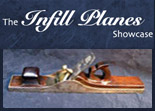Basic Tools For Metal Plane Making – Part II
Infill plane maker, Cameron Miller, gives a rundown of the basic tools needed for making metal planes. In this second part he concludes the article by concentrating on fabricating, marking and layout tools.
Joining And Fabricating Tools
Drills — Drills are essential for planemaking, not only to drill holes for rivets, lever caps and screws, but to ease in the initial shaping of the planes’ side plates through chain drilling. A set of metal twist drills up to at least 1/4″ (or the metric equivalent) should be purchased, although a set of drills up to 1/2″ will take care of most of your drilling requirements. Additional twist drills of different sizes can be bought as the need arises – such as in the case of various tap drills.
A countersink bit is also needed for making the many countersinks required for riveting. In a pinch this process can be done with a larger sized drill bit, but a countersink bit is more accurate and easier to use.
For making the slot in the rear infill for the blade screw a Forstner or sawtooth style drill bit is ideal. It’s also good for drilling the cut out in a closed type handle as well as any recesses that need to be made for adjuster mechanisms. A 7/8″ Forstner or sawtooth bit is the most versatile size, although other sizes are also quite useful. Of course you can drill these holes and recesses with a spade bit or a brad point style drill bit and then clean up with a chisel, but a Forstner or sawtooth bit will give a much flatter bottom with minimal clean-up.
As mentioned before a bench or pillar drill will greatly speed up your drilling processes and increase accuracy, but it is not a necessity. A hand drill or power drill – especially if it’s in a drill press – is quite adequate for making planes.
I might also add that recesses can be “milled out” using a router either freehand or preferably inverted in a router table. Although this may produce a cleaner finish it is often much quicker to drill a couple of holes and, if necessary, clean up with a chisel.
Taps & Dies — Occasionally you will need to cut threads. Most of these will be internal threads but in the case of lever cap screws or adjuster shafts you will need to cut some external threads. This is where a set of taps and dies becomes invaluable.
A tap is a very hard, and unfortunately brittle, tool that cuts an internal thread when it is screwed into a hole. The size of the hole must be accurate for the size of the tap, if it isn’t the right size then one of two things will occur. Either the threads may not be cut deep enough if the hole is too loose, or worse, break the tap if the hole is too tight.
There are three types of taps available. The first one is tapered and is used primarily to start a thread. The second, or intermediate tap, is used to tap a hole all the way through a piece of metal. This follows the threads cut by the first tap (also called a tapered tap). The final tap is known as a bottoming tap and is used to tap to the full depth of a blind hole. Not all of these types of tap are needed, but having them does make things easier. A tap wrench will be required to hold the taps securely.
A die is used to cut an external thread as in a thread on a bolt or a screw. Although there are many types available we are only interested in the split type which allows for some adjustment. Dies must be held in a die stock, which is usually purchased separately.
Even though I have both a set of imperial and metric taps I usually only use the imperial. Even then I mainly use a number of different sizes, the most common being: 3/16″, 1/4″, 3/8″, 1/2″ and occasionally 1/8″. It’s always good to have other sizes in reserve though.
To accurately mark holes ready for drilling and tapping a centre-punch is a must. Essentially a piece of high carbon steel with a point, it is used to indent a piece of metal or timber so as not to allow the twist drill to wander off course. A centre-punch can also be useful for peining difficult dove-tails.
Hammers — To pein the edges of dovetails and rivets, a ball pein hammer is necessary. A large engineers type is no good, as its size and weight cause more problems than solutions. The peining process is more like the incessant tapping of a woodpecker than the steady clang of heavy machinery. One or two light-weight ball pein hammers will be necessary. Make sure that the hammers are of reasonable quality, and that their heads are in good condition.
Anvils — Although a proper anvil is not necessary, you will need something on which to hammer and pein. Depending on the size and type of plane you’re making, anything from an industrial sized 500lb blacksmiths anvil down to a 3 inch square block of steel can be used – and I’ve used them both. Sometimes it may be desirable to drill one or two shallow holes in the top of the block to aid in the peining of rivets so that the plane is not rocking on the opposite end of the rivet but, generally speaking, the top should otherwise be smooth and free of defects.
Measuring, Marking and Layout Tools
It is important to at least be reasonably accurate when making planes. While it may not matter if the back of your plane handle extends 1/4″ further than you intended it to, it would be absolutely devastating if the dovetails on your side plates were out by the same margin. The easiest solution then, would be to simply remark and start again, and try to forget the many hours of work that were wasted. Of course I’m not trying to take away any of that “unknown” evolutionary or intuitive aspects that are often present in the creation of various things, but it must be stressed and understood that some measurements are extremely important if the finished article is to function properly. After all, if you want sloppy or inefficient tools, then there are plenty of them out there to buy, without having to build your own.
Rules — An accurate steel rule or two will be needed for making planes. It’s not important whether they are imperial or metric, as long as they’re able to be clearly read. Both a 6″ and a 12″ rule will be adequate for our needs however, like squares, I tend to have quite a few of them about. A rule with a conversion table stamped on the back is also an advantage.
Squares — Good quality squares – preferably machinists try squares – should be used for plane making. I tend to have quite a few squares around the workshop, just so I have no excuse for not using one, but you really only need one or two squares. You must make sure that each square is in fact square. Or your accuracy will be compromised. A woodworkers square will work fine if you don’t have a machinists square – as will a combination square. The added bonus of a combination square is that it comes complete with a protractor head and bevel gauge for measuring and marking angles — very useful for working out bedding angles.
Bevels — If you don’t have a combination square, then you may have to buy a sliding bevel. Although a machinists bevel is preferable for accuracy, a woodworkers sliding bevel will suffice. A protractor will also be needed to mark degrees and angles.
Awls & Scribes — Nothing fancy here. Just anything that can be used to lightly mark the surfaces in the metal prior to drilling or cutting. A nice hard tool steel is useful, but anything that can be used on wood will also work for metal.
Marking Gauges & Dovetail Markers — Another tool that is useful is a marking gauge to mark the depth of cut for the dovetails. While a wooden marking gauge will work, one made of metal will be much more durable. A dovetail marker or template will also save time and help increase accuracy, but you can mark out dovetails without it by just “sighting” them, then truing them up as you file.
This concludes the article on basic tools. Further down the track I’ll look into additional and more specialized tools that can be very useful indeed in making metal and infill planes.






